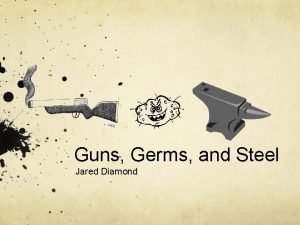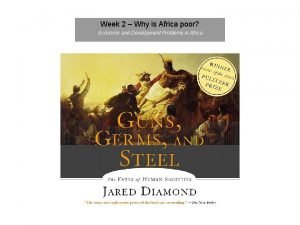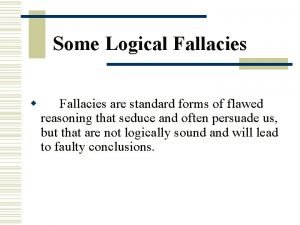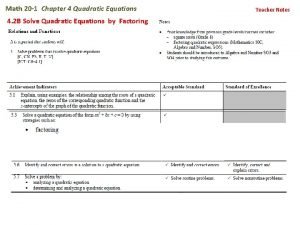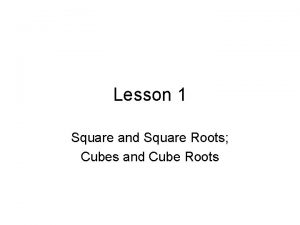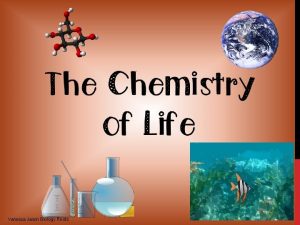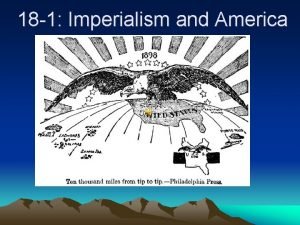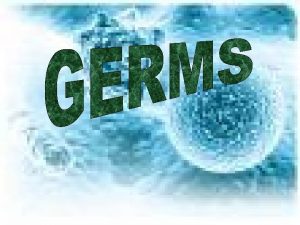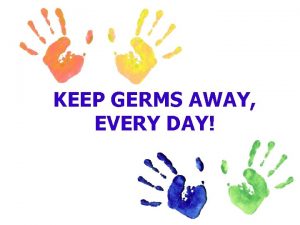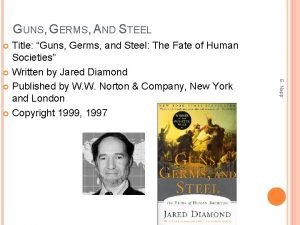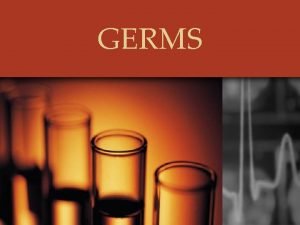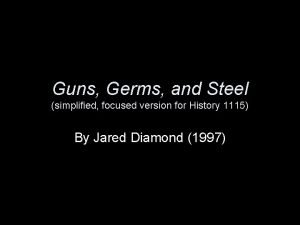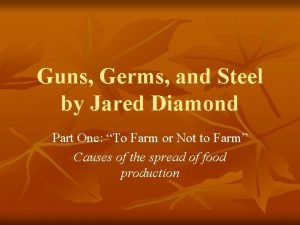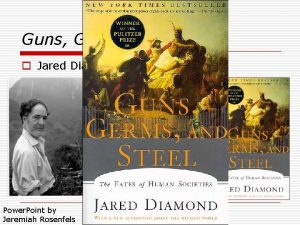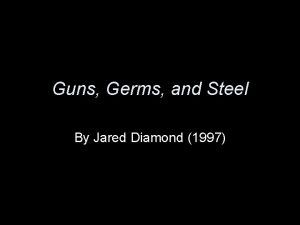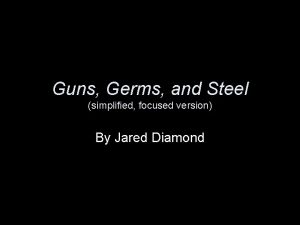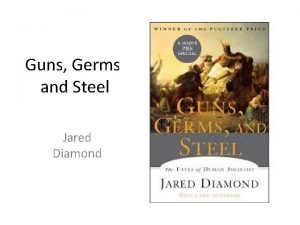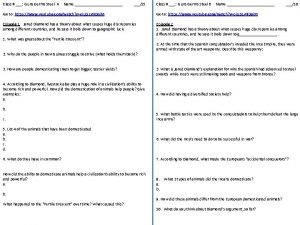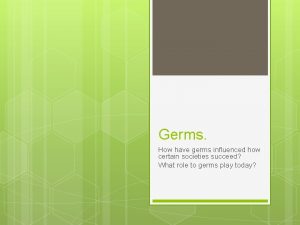Guns Germs and Steel What are the roots















- Slides: 15

Guns, Germs and Steel

What are the roots of inequality? • For one answer to that question, the class will examine thesis of Guns, Germs, and Steel by Jared Diamond as presented in his book of that title, which earned the Pulitzer Prize, and the National Geographic Society DVD of the same title. Professor Diamond explores the linkage between geography, technology, and global human development.

• Luca Cavalli-Sforza, professor of Genetics at Stanford University, noted that “…the question, ‘Why did human societies have such diverse fates? ’ has usually received racist answers. ” Jared Diamond convincingly demonstrates that head starts and local conditions can explain much of the course of human history. ” • For Christopher Ehret, professor of African History at UCLA, “Jared Diamond takes us on an exhilarating world tour of history that makes us rethink all our ideas about ourselves and other peoples and our places in the overall scheme of things. ” In a similar vein, Edward O. Wilson, Pellegrino University Professor at Harvard University, said Jared Diamond “shows how history and biology can enrich one another to produce a deeper understanding of the human condition. ”

• Diamond indicates that the motivating question for the book is “Why did history unfold differently on different continents? ” • There is a starting point: “In the 13, 000 years since the end of the last Ice Age, some parts of the world developed literate industrial societies with metal tools, other parts developed only non-literate farming societies, and still others retained societies of huntergathers with stone tools. Those historical inequalities have cast long shadows on the modern world…” (13)

• Diamond reformulated this question about inequality in the modern world as follows: Why did wealth and power become distributed as they now are, rather than in some other way? (15) Diamond then rephrases the organizing question as follows: “Why did human development proceed at such different rates on different continents? • Diamond’s question was then answered: “History followed different courses for different peoples because of difference among peoples’ environments, not because of biological differences among peoples themselves. ” (25)

• A theme which runs throughout the book is “…how chains of causes operate in history’s unfolding. ” (27) Hemispheres Colliding • “The basic questions to be answered is: why did Europeans reach and conquer the lands of Native Americans, instead of vice versa? ” (354) • The comparison begins with food production: “a major determinant of local population size and societal complexity—hence an ultimate factor behind the conquest. ” (354)

Food Production • 1. The most glaring difference between American and Eurasian food production involved big domestic mammal species: “…Eurasian’s 13 species, which became its chief source of animal protein (meat and milk), wood and hides, its main mode of land transport of people and goods to indispensable vehicles of warfare, and (by drawing plows and providing manure) a big enhancer of crop production. ” (355) • 2. “In contrast, the America’s had only one species of big domestic mammal, the llama/alpaca, confined to a small area of the Andes and the adjacent Peruvian coast. While it was used for meat, wool, hides, and goods transport, it never yielded milk for human consumption, never bore a rider, never pulled a cart or a plow, and never served as a power source or vehicle of warfare. ” (355) • 3. “…the sole missing ingredients required to sustain food production in large areas of the Americas were domestic animals and crops themselves. ” (356).

Infectious Diseases • 1. “The infectious diseases that regularly visited crowded Eurasian societies, and to which many Eurasians consequently developed immune or genetic resistance, included all of history’s most lethal killers: smallpox, measles, influenza, plague, tuberculosis, typhus, cholera, malaria, and others. ” (357) • 2. “…against that grim list, the sole crowd infectious diseases that can be attributed with certainty to pre. Columbian Native American societies were non syphilitic treponemas. ” (357) • 3. “…the infectious diseases that eventually became major obstacles to European colonization of the American tropics, and that posed the biggest barrier to the construction of the Panama Canal, are not American diseases at all but are caused by microbes of Old World tropical origin, introduced to the Americas by Europeans. ” (358)

All Aspects of Technology • 1. “These differences stemmed ultimately from Eurasia’s much longer history of densely populated, economically specialized, politically centralized, interacting and competing societies dependent on food production. ” (358) • 2. Five areas of technology are singled out: A. Metals for tools B. Military technology C. Sources of power for machines D. Land transport E. Sea transport (pp. 358 -359)

Political Organization • 1. “By late medieval or Renaissance times, most of Eurasia had come under the rule of organized states. ” 359 • 2. “Many Eurasian states and empires had official religions that contributed to state cohesion. ” (359) • 3. “The Americans had two empires, those of the Aztecs and Incas…” (360)

Writing • 1. “Most Eurasian states had literate bureaucracies…” (360) • 2. “…use of writing in the Americas was confined to the elite in a small areas of Mesoamerica. ” (360)

Future of Human History As a Science • The answer to Yali’s question is as follows: • “…the striking difference between the longterm histories of peoples of the different continents have been due not to innate differences in the peoples themselves but to differences in their environments. ” (405)

There are four sets of significant environmental differences: • Continental differences in wild plant and animal species available for domestications • Rates of diffusion and migration which differed greatly among continents • Factors Affecting Diffusion Between Continents • Continental Differences in Area or Total Population Size

An Observation • “All human societies contain inventive people. It’s just that some environments provide more starting materials, and more favorable conditions for utilizing inventions, than do other environments. ” (408)

Based on the Africa case study which was most important? A. B. C. D. Food Production Infectious Diseases All aspects of Technology Political Organization
 Fertile crescent
Fertile crescent Guns germs and steel worksheet
Guns germs and steel worksheet Guns germs and steel summary
Guns germs and steel summary Example of slippery slope
Example of slippery slope Mikael ferm
Mikael ferm Existence and uniqueness of square roots and cube roots
Existence and uniqueness of square roots and cube roots Perfect square definition
Perfect square definition Quadratic equations with fractions
Quadratic equations with fractions What are all of the perfect squares
What are all of the perfect squares Vanessa jason biology roots
Vanessa jason biology roots The roots of american imperialism 1. economic roots
The roots of american imperialism 1. economic roots What are germs
What are germs Germs are tiny
Germs are tiny Ssener
Ssener Keep germs away
Keep germs away Spread cheer not germs
Spread cheer not germs
